| Resultant Spd/Dir |
College Pt., Station Monitor | Bronx (Gerard Av) |
|||||||||
| Date | Fo | Rain | Wind | Event | EPA AIRNOW MAP dnld:Feb/2000 | Bv | O3 | NO2 | O3 | NO2 | Notes |
| 8/1/99 | 98o | 2.3mph 310 Haze |
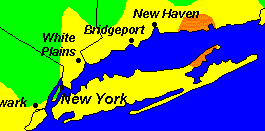 |
30 | .040 | .019 | .042 | .026 | |||
| 8/2/99 | 90o | 4.8mph 060 |
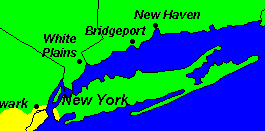 |
12 | .031 | .022 | .034 | .026 | |||
| 8/3/99 | 87o | 2.0mph 050 |
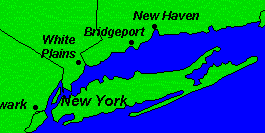 |
10 | .030 | .021 | .032 | .029 | |||
| 8/4/99 | 88o | 2.3mph 210 |
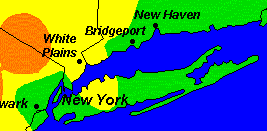 |
26 | .027 | .033 | .033 | .039 | |||
| 8/5/99 | 90o | 0.12 | 1.7mph 250 Fog+ Mist |
"Onset dates [for human WN virus encephalitis] ranged from August 5 to September 16... although no cases had onset in New York City after control measures were extended to the entire city on September 11. The median age of case-patients was 71 years (range: 15-87 years), with the most severe clinical cases and all fatalities occurring among older persons." | 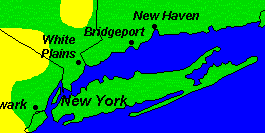 |
12 | .021 | .044 | .025 | .049 | CDC MMWR 10/1/99 |
| 8/6/99 | 88o | 2.3mph 290 |
[0.1 inch rain. Negligible for mosquito larvae maturation (10 to 14 days). This is the first rain since July 2nd which was only 0.2 inch. Previous rain was 1.5 inches, on May 25th.] | 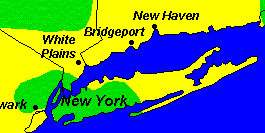 |
14 | .027 | .037 | .038 | .033 | ||
| 8/7/99 | 88o | 0.9mph 210 |
"In early August... wildlife experts... began to notice the deaths of large numbers of crows around the state and in New Jersey." | 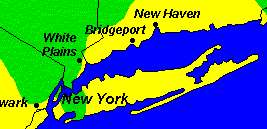 |
14 | .044 | .019 | .044 | .026 | NYT 9/28/99 | |
| "That silence is the sound of a mosquito-free summer. [...] As an exceptionally hot and dry summer plagues farmers throughout the Eastern Seaboard and Midwest, there has been one upside: mosquitoes are as scarce as the little puddles and pools their eggs need to hatch. Truth be told, the season is not quite mosquito free. There have been scattered swarms of the salt-water mosquitoes that breed in coastal marshes whenever high tide comes. But the far more common species that blanket inland areas each year are largely missing. [para] In Connecticut, scientists found an average of 250 mosquitoes a week in each of their 37 traps during last July; this July, it was about 75. On Long Island, Suffolk County's mosquito catch for the entire month of July was 6,152 -- compared with 27,161 last summer. In Monmouth County, N.J., mosquito- watchers counted 1,711 in traps last month, about a fifth of the typical July yield over the previous six years. 'It's been, probably, the quietest summer we've had in years,' said Martin Chomsky, superintendent of the Monmouth County Mosquito Extermination Commission. 'I would say that this is a record year in terms of the lack of freshwater mosquitoes.'" Note, this conflicts with statements after the epidemic that the population of Culex mosquitoes was exploding because of drought, when the concept of the "natural transmission cycle" needed reinforcement. | NYT 8/7/99 | ||||||||||
| 8/8/99 | 81o | 4.2mph 280 Mist Haze |
"'[Since about 8/8/99,] ...we've been getting reports on a daily basis about dead and dying crows around there [ Fort Totten, Flushing, Kings Point in Great Neck, and Throgs Neck in the Bronx, ],' Mr. Lieblein [NYSDEC] said." | 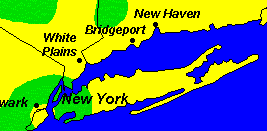 |
15 | .046 | .021 | .045 | .028 | NYT 9/28/99 | |
| 8/9/99 | 82o | 3.5mph 340 |
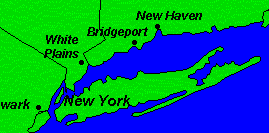 |
10 | .022 | .021 | .027 | .020 | |||
| 8/10/99 | 80o | 0.9mph 170 |
Almost no wind movement. | 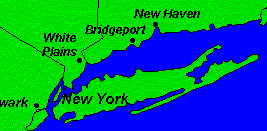 |
10 | .018 | .031 | .019 | .033 | ||
| 8/11/99 | 84o | 0.05 | 1.9mph 180 Mist Haze |
Almost no wind movement. | 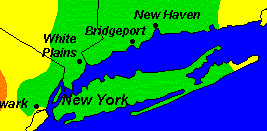 |
14 | .030 | .035 | .024 | .043 | |
| 8/12/99 | 88o | 1.1mph 110 Mist Haze |
Almost no wind movement. "The first patient had arrived [at Flushing Hospital, Queens] on Aug. 12, feverish and delirious. After three days in intensive care, he couldn't lift his arms off the bed." |
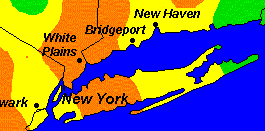 |
50 | .034 | .034 | .032 | .039 | AP and Nando Times 12/5/99 | |
| 8/13/99 | 88o | 0.02 | 4.1mph 200 Mist Haze |
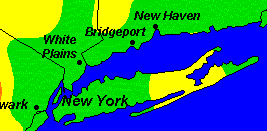 |
20 | .020 | .022 | .010 | .034 | ||
| "In mid-August, [date conflicts with numerous other articles. See late July] Dr. Tracey McNamara, a veterinary pathologist with the Wildlife Conservation Society, at the Bronx Zoo, began hearing reports of dead birds all around New York City. Then she noticed dozens of dead and sick crows around the zoo. 'I'm sitting there saying, 'It's raining crows,' she recalls. "The sick ones were neurologic -- they couldn't fly, they had trouble balancing. They were sitting there with tremors.' Dr. McNamara performed necropsies, and when she opened the birds' skulls she found that they'd had brain hemorrhages; she also found lesions on their hearts." | The New Yorker, 10/18/99 & 10/25/99 | ||||||||||
| 8/14/99 | 86o | 0.78 | 0.0mph VarDir Fog+ Mist Haze |
[Rain. This is the first rain of the summer since May 25, which would be capable of sustaining mosquito larvae. It takes 11 to 16 days for the larvae maturation cycle to produce mated female mosquitoes, which will need blood protein for their eggs. (Larvae cycle information from NYT 8/7/99)] | 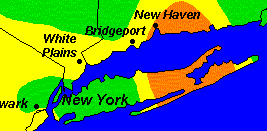 |
15 | .041 | .028 | .028 | .042 | Central Park Obs. (NOAA) |
| 8/15/99 | 82o | Trace | N/A Mist |
"On Aug. 15, a second [encephalitis] patient arrived [at Flushing Hospital, Queens] with the same symptoms." | 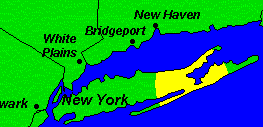 |
13 | .021 | .014 | .016 | .018 | AP and Nando Times 12/5/99 |
| 8/16/99 | 86o | N/A |
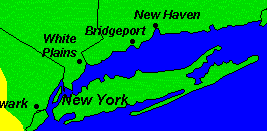 |
12 | .018 | .028 | .019 | .031 | |||
| 8/17/99 | 86o | 3.5mph 250 Mist Haze |
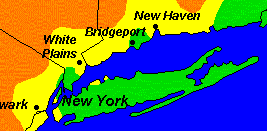 |
15 | .026 | .034 | .022 | .041 | |||
| 8/18/99 | 88o | 2.1mph 310 Haze |
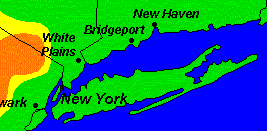 |
13 | .032 | .031 | .031 | .030 | |||
| 8/19/99 | 82o | 2.7mph 100 |
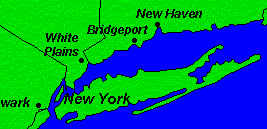 |
10 | .023 | .022 | .019 | .026 | |||
| 8/20/99 | 74o | 0.26 | 8.7mph 100 Mist |
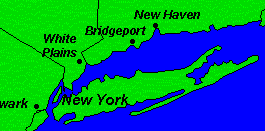 |
10 | .017 | .021 | .015 | .025 | ||
| 8/21/99 | 64o | 0.05 | 8.6mph 70 Mist |
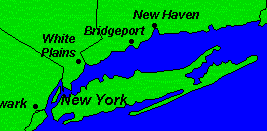 |
10 | .019 | .015 | .009 | .024 | ||
| 8/22/99 | 72o | 0.8mph 320 |
"But they are, and not just in Fort Totten. They have also been found dead in Flushing, Kings Point in Great Neck and Throgs Neck in the Bronx, said Robert Lieblein, a spokesman for the state's Department of Environmental Conservation. [para] | 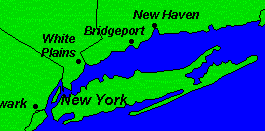 |
10 | .014 | .018 | .010 | .020 | NYT 8/22/99 | |
| "'Since two weeks ago [8/8/99] , we've been getting reports on a daily basis about dead and dying crows around there,' Mr. Lieblein said. Eight dead crows, several from each area, were frozen and sent to state laboratories in Albany for autopsies, he said. Results are expected this week. [para] Dr. John Charos, a veterinarian who has an office in Bayside, said that clients had brought in many sick crows during the last three weeks. He nursed some back to health with antibiotics [also indoor shelter, rest, and nutrition] and then released them. [para] Crows, which are hearty scavengers, are affected much less frequently than other birds by spoiled food and bacteria. 'This is a bird that can live on road kill,' he said, 'so the amount you have dying now, you have to wonder if they're being poisoned.' [...] Ms. Weiss [Alley Pond Environmental Group] wondered if the crows had found toxic food elsewhere, perhaps from rodents that may have been poisoned or that had died from drought conditions. Local grazers, like geese, ducks and pigeons, have gone mostly unaffected, she said." [Record-high photochemical smog and MTBE are not mentioned. The NYS DEC pathology laboratory has no capability or funding to perform toxicology autopsies that could determine toxicity by atmospheric pollution.] | NYT 8/22/99 | ||||||||||
| 8/23/99 | 86o | 1.0mph 320 |
A WNV hospital case. [I saw this listed, 12/11/00, at Medical Library conference, by Dr. Layton. | 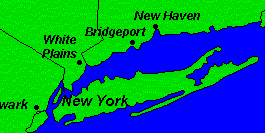 |
10 | .017 | .038 | .013 | .035 | ||
| 8/24/99 | 87o | 1.8mph 250 Haze |
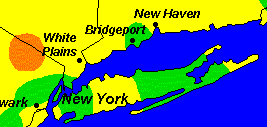 |
32 | .020 | .053 | .015 | .051 | |||
| 8/25/99 | 81o | Trace | 3.0mph 170 Mist |
[This is the earliest possible occurance of a substantial mosquito population for this summer. Otherwise they must be considered to be 1/5th the usual number.] | 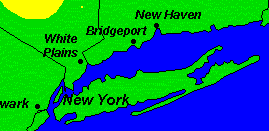 |
12 | .025 | .029 | .021 | .034 | See 8/14/99, above. |
| 8/26/99 | 76o | 1.53 | 6.2mph 090 Fog+ Mist |
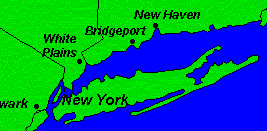 |
10 | .018 | .021 | .013 | .025 | ||
| 8/27/99 | 82o | 0.05 | 0.9mph 210 Mist Haze |
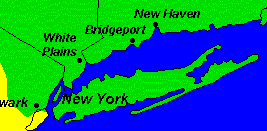 |
12 | .024 | .038 | .017 | .047 | ||
| 8/28/99 | 87o | 2.8mph 290 Mist Haze |
"On Saturday, Aug. 28, a fifth case was reported from another hospital. [para] Dr. Layton and Dr. Fine, concerned about the small but growing number of cases, went to Flushing Hospital to review the patients' charts firsthand. [para] 'As we were sitting in the hospital we heard of another case,' the sixth, Dr. Layton said. [para] The six patients' symptoms were not identical." | 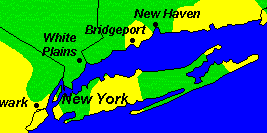 |
20 | .034 | .034 | .029 | .034 | NYT 9/9/99 | |
| [CDC's graphic analysis (10/1/99) shows 8/22-8/28 to be the apex of the WNV encephalitis epidemic, in terms of seropositive onsets. www.cdc.gov/epo/mmwr/preview/mmwrhtml/mm4841a3.htm] | CDC 10/21/99 | ||||||||||
| 8/29/99 | 89o | 3.7mph 360 Haze |
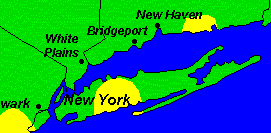 |
15 | .035 | .022 | .029 | .023 | |||
| 8/30/99 | 71o | 11.2mph 060 |
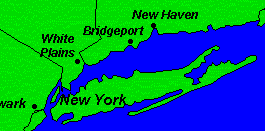 |
10 | .013 | .014 | .010 | .019 | |||
| 8/31/99 | 75o | 6.9mph 090 |
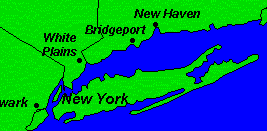 |
10 | .023 | .018 | .016 | .024 | |||